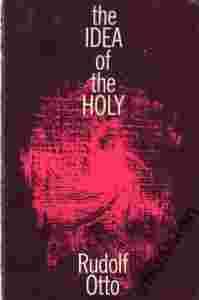|
Rudolf Otto
The Idea of the Holy
An Inquiry into the non-rational factor in the idea of the divine and its relation to the rational
Oxford University Press 1958
Stron XXI+232, format: 13,5x20 cm
Książka używana: stan dobry plus, bez defektów.
Before religión became "morality touched with emotion" it was the emotion itself, or a group of emotions, and it still is. Those emotions are, in the translator's summary, "the feeling of the 'uncanny,' the thrill of awe or r¿verence, the sense of dependence, of impotence, or of nothingness, or again, the feelings of religious rapture and exaltation."The author of the present book calis them the non-rational feelings, the sense of the tremendous, the awful, the mysterious, or, in a word of his own choosing, the "numinous."Both author and translator make it clear that religión must accommodate both the numinous and the ethical. The Idea of the Holy (Das Heilige), which is fundamentally an inquiry into the non-rational factor in the idea of the divine and its relation to the rational, is a book which has established itself, since the English translation first appeared in 1923, as a classic in the field of religious philosophy.
"It is a book that every Christian thinker needs, and this translation has firmly established its position as an authorita-tive and lucid representation of an acknowledged classic of religious thought.'—London Quarterly Review
Rudolf Otto, who died in 1937, was born at Peine in Hanover in 1869. He traveled widely and in 1910 set out on a long journey to the East which was to take him round the world. In 1917 he was appointed to a Chair of Theology at Marburg-on-the-Lahn, and"one of the special ihterests in the last ten years of his life was the establishment at Marburg of a museum for the comparative study of religions, not as dead curiosities but as living faiths."
CONTENTS
translator's preface to second edition ix
note on appendixes, &c xx
foreword by the author (to first english edition) Xxi
i. the rational and the non-rational i
n. 'numen' and the 'numinous' 5
hi. the elements in the 'numinous'
Creature-feeling 8
iv. mysterium tremendum
the analysis of 'tremendum* 12
1. The Element of Awefulness 13
2. The Element of'Overpoweringness' 19
3. The Element of 'Energy' or Urgency 23
v. the analysis of 'mysterium'
4. The 'Wholly Other' 25
vi. 5. the element of fascination 31
vh. analogies and associated feelings 41
The Law of the Association of Feelings 42
Schematization 45
Vm. the holy as a category of value t
Sin and Atonement 50
lx. means of expression of the numinous:
5. Direct Means 60
6. Indirect Means 61
7. Means by which the Numinous is expressed in Art 65
x. the numinous in the old testament j2
xi. the numinous in the new testament 82
xh. the numinous in luther 94
xih. the two processes of development IO9
Vlil contents
xiv. the holy as an a priori category. part i 112
xv. its earliest manifestations 117
xvi. the 'cruder' phases 132
xvii. the holy as an a priori category. part ii 136
xviii. the manifestations of the 'holy' and the faculty of 'divination' 143
xix. divination in primitive christianity 155
xx. divination in christianity to-day 162
xxi. history and the a priori in religion: summary and conclusion 175
appendixes:
I. Chrysostom on the Inconceivable in God 179
ii. The Numinous in Poetry, Hymn, and Liturgy 186
in. Original Numinous Sounds 190
iv. 'Spirit' and 'Soul' as Numinous Entities 193
v. The Supra-personal in the Numinous 197
vi. The Mystical Element in Luther's Conception of 'Faith' 204
vii. 'Signs Following' 207
viii. Silent Worship 210
ix. A Numinous Experience of John Ruskin 215
x. The Expression of the Numinous in English 216
xi. The Mysterium Tremendum in Robertson and Watts 220
xii. The Resurrection as a Spiritual Experience 222
xiii. Religious Essays, A Supplement to 'The Idea of the Holy" (O.U.P.): table of contents 229
index 230
|

